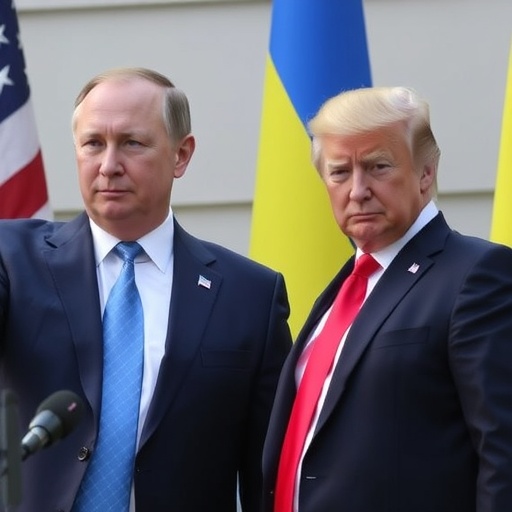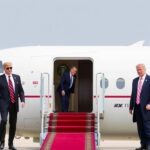US, Russia, and Ukraine Edge Toward Diplomatic Solution in Ukraine War: Trump-Putin Summit Postponed for Key Talks
In a stunning development that could reshape the geopolitical landscape, Russian envoy Kirill Dmitriev announced today that the United States, Russia, and Ukraine are on the brink of a diplomatic solution to end the protracted Ukraine war. This hopeful revelation comes just as a highly anticipated summit between U.S. President Donald Trump and Russian President Vladimir Putin has been unexpectedly delayed, buying precious time for negotiators to iron out the final details.
- Dmitriev’s Revelation Ignites Global Optimism Amid Ukraine War Fatigue
- Behind the Delay: Why the Trump-Putin Summit Faces Indefinite Postponement
- Key Players and Sticking Points in the Push for Ukraine War Resolution
- International Community Reacts to Hopes of Diplomatic Breakthrough
- Path Forward: Implications of a Potential Ukraine War Endgame
The announcement, made during a press briefing in Moscow, has sent ripples through international capitals, offering a glimmer of hope after more than two years of devastating conflict. Dmitriev, a key figure in Russia’s economic diplomacy, emphasized that “substantive progress” has been achieved in backchannel talks, though he cautioned that the path to peace remains delicate. With the Ukraine war claiming tens of thousands of lives and displacing millions, this potential breakthrough arrives at a critical juncture, especially as winter looms and global energy markets teeter on the edge of instability.
President Trump, who has long advocated for direct engagement with Putin to resolve the crisis, expressed cautious optimism in a statement from the White House. “We’re close—very close—to making a deal that stops the fighting and brings our people home,” Trump said, underscoring his administration’s commitment to a swift resolution. However, the postponement of the Trump-Putin summit, originally slated for next month in Geneva, highlights the complexities involved in bridging deep-seated divides.
Dmitriev’s Revelation Ignites Global Optimism Amid Ukraine War Fatigue
Kirill Dmitriev’s statement marks a pivotal moment in the drawn-out saga of the Ukraine war, which erupted in February 2022 with Russia’s full-scale invasion. As the CEO of Russia’s Direct Investment Fund, Dmitriev has been instrumental in fostering economic ties, but his role has expanded into diplomatic channels, particularly in discussions involving Western sanctions and reconstruction plans. Speaking to reporters, Dmitriev declared, “The parties are nearing a diplomatic solution that addresses core security concerns for all involved.” This comes after months of intensified shuttle diplomacy, including virtual meetings facilitated by neutral mediators from Turkey and Qatar.
The Ukraine war has exacted a staggering toll: according to United Nations estimates, over 10,000 civilians have been killed, with the actual figure likely much higher due to underreporting in contested areas. Economically, the conflict has driven global inflation, with wheat prices surging by 30% in the war’s early months, exacerbating food insecurity in Africa and the Middle East. Dmitriev’s words suggest that negotiators are focusing on territorial compromises, demilitarization zones, and guarantees against NATO expansion—issues that have long been flashpoints between Moscow and Kyiv.
Experts attribute this surge in optimism to a confluence of factors. U.S. special envoy Keith Kellogg, a retired general with deep ties to Trump’s inner circle, has reportedly played a hands-on role in recent talks. Sources familiar with the negotiations indicate that informal agreements on prisoner exchanges and humanitarian corridors have already been implemented, building trust ahead of broader accords. Yet, skepticism persists; Ukrainian President Volodymyr Zelenskyy, in a televised address, urged caution, stating, “Peace must be just and enduring, not a temporary pause.”
The emotional weight of Dmitriev’s announcement cannot be overstated. Families on all sides of the conflict have endured unimaginable loss. In Ukraine, cities like Kharkiv and Mariupol bear the scars of relentless bombardment, while Russian conscripts’ mothers have staged protests demanding their sons’ return. This diplomatic thaw offers a narrative of redemption, transforming a story of destruction into one of potential reconciliation.
Behind the Delay: Why the Trump-Putin Summit Faces Indefinite Postponement
The postponement of the Trump-Putin summit underscores the intricate dance of diplomacy in the Ukraine war. Initially announced as a landmark event to build on Trump’s 2018 Helsinki meeting with Putin, the summit was envisioned as a platform for face-to-face breakthroughs. However, insiders reveal that logistical hurdles and substantive disagreements prompted the delay, with no new date set pending “further alignment on key issues.”
One major sticking point appears to be the sequencing of concessions. Russia insists on written assurances from the U.S. regarding Ukraine’s neutral status before any troop withdrawals, while Kyiv demands verifiable de-escalation on the ground first. Trump, known for his deal-making prowess, has reportedly intervened personally, tweeting last week, “Big progress with Putin on Ukraine—stay tuned!” But the delay allows for quieter, less public negotiations, potentially averting the spectacle of a high-stakes summit derailing over optics.
Historical parallels abound. The 2015 Minsk agreements, aimed at ending fighting in eastern Ukraine, collapsed due to mutual distrust, leading to the full invasion. This time, mediators are emphasizing enforceable mechanisms, such as UN-monitored ceasefires and international arbitration panels. Statistics from the International Crisis Group show that over 500,000 troops remain deployed along the front lines, making any misstep in timing catastrophic.
Critics in Washington, including Senate Foreign Relations Committee Chair Bob Menendez, have voiced concerns that the delay might signal concessions to Moscow. “We can’t rush into a diplomatic solution that undermines Ukraine’s sovereignty,” Menendez warned in a floor speech. Conversely, pro-Trump voices argue the postponement is strategic, allowing the president to leverage economic pressures—like renewed sanctions on Russian oligarchs—to extract better terms.
The human element adds urgency. Refugee camps in Poland and Romania house over 4 million displaced Ukrainians, many children who have known only war. Delaying the summit, while frustrating, could prevent premature commitments that unravel under scrutiny, paving the way for a more robust diplomatic solution.
Key Players and Sticking Points in the Push for Ukraine War Resolution
At the heart of these negotiations are three towering figures: Trump, Putin, and Zelenskyy, each navigating domestic pressures and international expectations. Trump’s approach to the Ukraine war has evolved since his first term, where he faced impeachment over a call with Zelenskyy. Now, with a mandate for “America First” foreign policy, he positions the diplomatic solution as a win against endless wars, echoing his criticisms of Biden-era aid packages totaling $175 billion.
Putin, facing internal economic strains from sanctions that have shrunk Russia’s GDP by 2.1% last year, sees the summit as a chance to lift isolation. Russian state media has amplified Dmitriev’s message, portraying the talks as a victory for Moscow’s resilience. Yet, hardliners in the Kremlin, including Security Council Secretary Nikolai Patrushev, reportedly resist any perceived weakness, complicating Putin’s maneuvers.
Zelenskyy, the unlikely wartime leader, balances Western support with the realities on the ground. Ukraine’s military, bolstered by U.S.-supplied HIMARS systems, has reclaimed swathes of territory, but at a cost: over 70,000 soldiers killed or wounded, per Kyiv’s estimates. In recent concessions, Ukraine has signaled flexibility on autonomy for Russian-speaking regions, a nod to federalization models like Bosnia’s.
Sticking points include Crimea, annexed by Russia in 2014, and the Donbas enclaves. A potential deal might involve deferred referendums or economic integration pacts. Quotes from negotiators hint at progress: EU foreign policy chief Josep Borrell noted, “We’re seeing movement on black swan issues that once seemed impossible.” Economically, a resolution could unlock $500 billion in frozen Russian assets for Ukraine’s rebuilding, per World Bank projections.
Broader context reveals U.S. strategic interests. With China watching closely, Trump aims to demonstrate diplomatic heft, potentially stabilizing energy markets where Russian gas once dominated Europe. The Ukraine war’s ripple effects— from Baltic Sea naval tensions to African grain shortages—make this a global imperative.
International Community Reacts to Hopes of Diplomatic Breakthrough
The world has responded with a mix of guarded enthusiasm and pointed calls for vigilance. NATO Secretary General Jens Stoltenberg welcomed the developments but stressed, “Any diplomatic solution must respect Ukraine’s right to self-determination.” In Beijing, officials expressed support for multilateral talks, viewing the Ukraine war as a proxy for U.S.-Russia rivalry that indirectly benefits China’s influence in Asia.
European leaders, weary of hosting Ukrainian refugees and subsidizing energy imports, are pushing for swift action. German Chancellor Olaf Scholz, whose country has committed €20 billion in aid, said in Berlin, “A ceasefire now, followed by a comprehensive diplomatic solution— that’s the path forward.” Poland, on the front lines, has ramped up border defenses, fearing spillover if talks falter.
In the Global South, nations like India and Brazil, abstaining from UN votes on the Ukraine war, advocate neutrality. Indian Prime Minister Narendra Modi recently hosted Zelenskyy, signaling a balancing act. Humanitarian organizations, including the Red Cross, report that a truce could save 100,000 lives annually through unhindered aid delivery.
U.S. allies in the Middle East, such as Saudi Arabia, are quietly mediating energy aspects, given the war’s role in spiking oil prices to $90 per barrel. Quotes from analysts underscore the stakes: “This isn’t just about Ukraine; it’s about preventing a new Cold War,” said Fiona Hill, former Trump advisor, in a CNN interview.
The postponement of the Trump-Putin summit has tempered some excitement, but it also allows for inclusive formats, potentially involving the UN Security Council. As one diplomat quipped anonymously, “Delay is not denial—it’s diplomacy at work.”
Path Forward: Implications of a Potential Ukraine War Endgame
Looking ahead, a successful diplomatic solution could redefine global security architecture. If achieved, it might include a 10-year non-aggression pact, economic reconstruction funds, and reformed arms control treaties echoing the expired New START. For Trump, securing peace would bolster his legacy, allowing focus on domestic priorities like border security.
Putin could claim a strategic win, easing sanctions and reintegrating Russia into global finance. Ukraine, though scarred, stands to gain sovereignty guarantees and EU accession fast-tracks, with Zelenskyy eyeing 2030 as a membership target. Economists predict a 5% GDP boost for Europe post-resolution, as supply chains normalize.
Challenges remain: verification regimes to prevent rearmament, addressing war crimes via an international tribunal, and healing societal divides. Next steps involve working-level talks in Vienna next week, where envoys will draft a framework agreement. If momentum holds, the Trump-Putin summit could reconvene by spring, sealing the deal.
The human stories at stake—farmers in Kherson fields, engineers rebuilding Kyiv’s grid—fuel the urgency. As Dmitriev put it, “Peace is not just an end to war; it’s a beginning for prosperity.” With the world watching, the coming months will test whether this diplomatic solution endures or evaporates like past accords.
In the shadow of delayed summits and whispered deals, the Ukraine war’s end feels tantalizingly close, promising a world less fractured and more hopeful.









